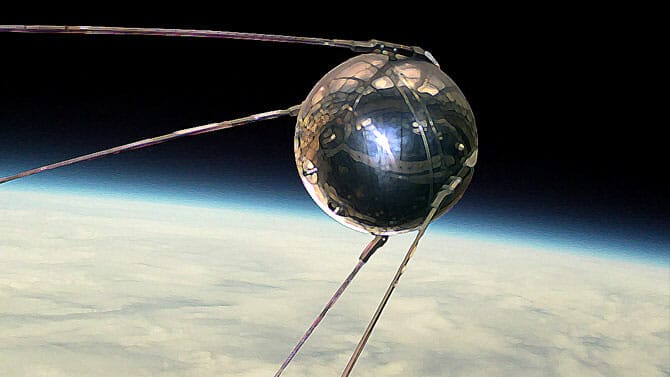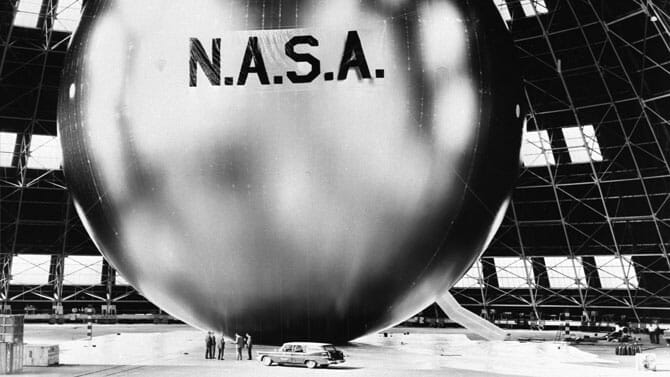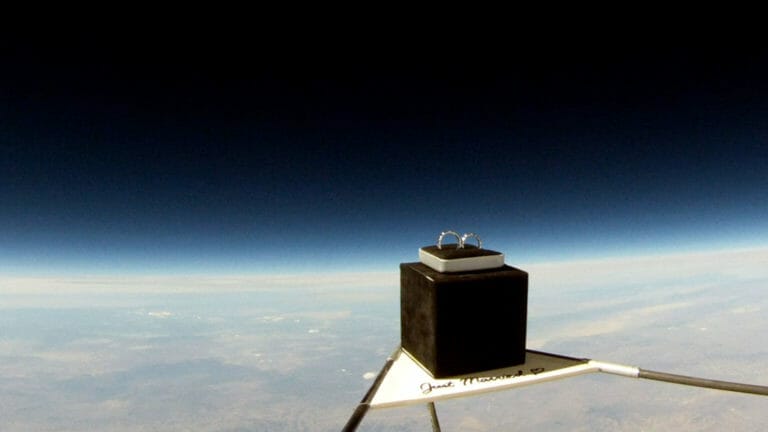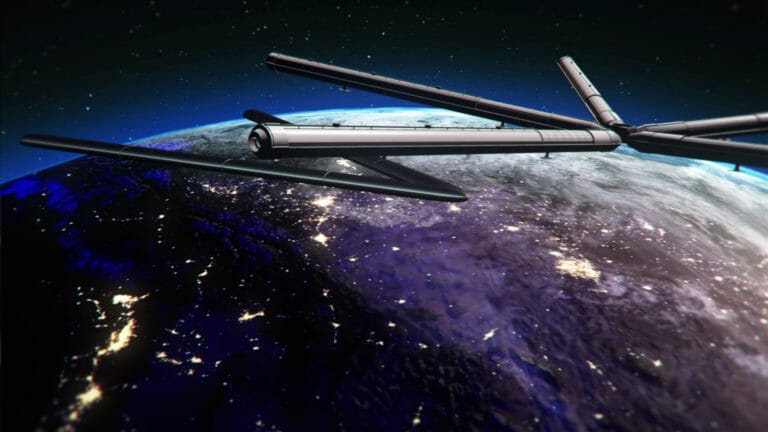
Beyond Geek Series Previews
Beyond Geek Series Previews Previews Season 2 Season 2 Episodes Kinetic Sculpture Racing Kinetic Sculpture Racing 2 The Force is Strong Hackathon A Pirate’s Life

by Sage Michael | Beyond Geek
Okay, so where in our great history of space exploration shall we begin? Well… as in all great stories, perhaps it is best to start at the beginning.
In the beginning there was Sputnik.
Imagine Sputnik like you would a 2-foot diameter volleyball, named Wilson. Sputnik was what the Russians called an Elementary Satellite, and indeed it was. The Russians launched Sputnik (a small, silver sphere) into the atmosphere and by doing so, started a panic here in the US that our President called “The Sputnik Crisis.”
In hindsight, of course, we see that the crisis was anything but. In fact, arguably, quite the opposite happened.
Our government, feeling that we were falling behind, actually poured billions of dollars into education with the National Defense Education Act. They also founded DARPA which, among other things, has given us things like computer networks and by extension, the Internet.
But let’s get back to our 23-inch diameter Wilson.
Sputnik traveled at around 18,000 miles an hour, which meant it could orbit the entire planet in about an hour and a half. It did that for 3 months. Which meant that it covered 37-million miles until forces like gravity caused the orbit to decay, pulling it back into our denser atmosphere where things like friction, speed, resistance, and drag eventually caused it to disintegrate.
So how did they fit all the gas and engines and stuff inside a beach-ball? Here’s the secret: they didn’t.
As it turns out the Earth, like Sputnik, is round. That means if you threw Wilson fast enough it would never hit the ground—ever. That’s called orbit.
You see, for every 5 miles straight out in front of you, our planet drops approximately 16 feet on average because remember, it’s round. So you are never really traveling in a straight line. You are just walking on the outer edge of a gigantic circle. So as you shoot that projectile forward, and gravity makes it want to drop to the ground, well… if it’s fast enough and has gone far enough, there is no ground on which it can actually drop. It will have traveled over the horizon and, effectively, off the edge of the planet.
So in order to launch an item into space, all you have to do is get it high enough into the air to avoid wind resistance, atmospheric pressure and drag. And then send it out in a parallel to the surface of the planet. By the way, it drops those 16 feet every single second, so if you are going launch something into orbit, it better go at least 5-miles per second. That’s why Sputnik had to go so fast, and that’s why it had to be so simple and light.
Originally, it was neither simple nor light, and therefore did not succeed.
First of all, it was a cone—and not the perfect .5 drag of a theoretical cone, either. It was more like a 2.08. That doesn’t sound like much but it’s like putting your hand out the window of a moving car and moving it from parallel to the ground (palm down) to instead turning it palm-forward (perpendicular to the ground).
Notice the difference? So did the Soviets. That’s why they tossed Wilson up into the air instead. Wouldn’t you?
To be fair, some of our satellites today also have very high drag coefficients (in the range of about 2 to 4), but today we have the knowledge and the thrust to overcome that. We are also not in a Cold-War Space Race. This being the case, simplicity won out.
And Sputnik was in fact quite simple. It went from the complex shape that it was, down to a sphere. It dropped an unbelievable amount of weight as well, going from 2,925 pounds to only about 183 pounds. The instruments inside it were also radically altered. Instead of it having a lot of scientific equipment aboard, they opted for just a radio transmitter.
This way, the Soviets could still learn things about our upper atmosphere… things like how dense it was, and the drag that was created in case they wanted to explore things even further out in space.
Well played, Russians. Well played.
And as you can probably guess, the great space race did not stop there, it had only just begun. In fact today that race has traveled so far, and so fast, that now literally anyone can put a satellite into space, and if it’s small enough… then you can even do so for free!
Imagine the great leaps that had to happen in history for us to get this point, and you will begin to see just how cool that concept actually is. The way it works is actually quite interesting and even borrows a little from its Sputnik predecessor. Think of little circles traveling through space and you’ll see what I mean.
Today a company called JP Aerospace will let users at home—literally anyone, even grade-schoolers—send them a small satellite and they will launch it for you completely free of charge as part of their PongSat program. There is a tiny catch, however… and when I say tiny… I mean the size of a ping-pong ball! Yes… you can launch practically whatever you want, but the space is limited to just that size.
So that’s what people send them. They just cut a ping-pong ball open and fill their soon-to-be satellite up with whatever experiment they like.
For the most part, if it fits, it ships! Don’t send them live animals or explosives, of course… but if you can dream it up and fill up a little ping-pong ball with it, you can literally run your own space program. It’s got a nice bit of resonance with the Wilson of our ancestors when you think about it. Simple circles flying through space. Perhaps coolest of all is that JP Aerospace does all this for free.

Beyond Geek Series Previews Previews Season 2 Season 2 Episodes Kinetic Sculpture Racing Kinetic Sculpture Racing 2 The Force is Strong Hackathon A Pirate’s Life

Starship Valiant is a new web series in development at Starbase Studios and created by Michael L. King.

Brittni Barger journeys into the final frontier with some passionate fans that don’t just want to watch Star Trek, they want to create it as well.

Brittni Barger learns the way of the Jedi with some highly dedicated Star Wars fans.

If this were the 1940’s, you would already know about Bing Crosby, Louis Armstrong, and Tennessee Williams. Roosevelt might be your President, and Generals Eisenhower, Patton and MacArthur might even be your heroes.

Deleted scene from “Floating to Space” episode

JP Aerospace wanted to open space up to everyone. They came up with a program that would cost nothing for a budding scientist to fly an experiment to the edge of space.

Nate Lake reaches for the final frontier with JP Aerospace, a group who has spent the past 30 years trying to find a new way into space.
Subscribe to our newsletter for updates, giveaways, and other geek news
*By clicking on the button, you agree with Terms Of Use and Privacy Policy.
Subscribe to our newsletter for updates, giveaways, and other geek news
*By clicking on the button, you agree with Terms Of Use and Privacy Policy.
Subscribe to our newsletter for updates, giveaways, and other geek news
*By clicking on the button, you agree with Terms Of Use and Privacy Policy.